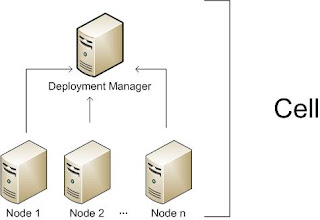In this post I will try put together a brief on WAS concepts and overview required to go ahead with the deployment plan.
WebSphere Application Server: An overview
WAS is the implementation by IBM of the Java 2 Enterprise Edition (J2EE) platform. It conforms to the J2EE 1.4 specification.
WebSphere Application Server is available in three unique packages that are designed to meet a wide range of customer requirements.
_ IBM WebSphere Application Server - Express V6
_ IBM WebSphere Application Server V6 - Base
_ IBM WebSphere Application Server Network Deployment V6
Network deployment platform
We used Network deployment (ND) version for the installation described below.
With ND, a distributed server configuration can be set up, which enables
# central administration,
# workload management and
# failover.
Application servers, nodes, and cells
Regardless of the configuration, the WebSphere Application Server is organized based on the concept of cells, nodes, and servers. While all of these elements are present in each configuration, cells and nodes do not play an important role until you take advantage of the features provided with Network Deployment.
Application servers
The application server is the primary runtime component in all configurations and is where an application actually executes. All WebSphere Application Server configurations can have one or more application servers. In the Express and Base configurations, each application server works as a separate entity. There is no workload distribution or common administration among application servers. With Network Deployment, a distributed server environment can be built consisting of multiple application servers maintained from a central administration point. In a distributed server environment, one can cluster application servers for workload distribution.
Nodes, node groups, and node agents
A node is a logical grouping of server processes that are managed by WebSphere and that share common configuration and operational control. A node is associated with one physical installation of WebSphere Application Server. In a stand-alone application server configuration, there is only one node. With Network Deployment, multiple nodes can be configured that can be managed from one common administration server. In these centralized management configurations, each node has a node agent that works with a deployment manager to manage administration processes.
A node group is a new concept introduced with WebSphere Application Server V6. A node group is a grouping of nodes within a cell that have similar capabilities. A node group validates that the node is capable of performing certain functions before allowing those functions. For example, a cluster cannot contain both z/OS nodes and nodes that are not z/OS. In this case, multiple node groups (one for the z/OS nodes and one for nodes other than z/OS) can be defined. A DefaultNodeGroup is automatically created based on the deployment manager platform. This node group contains the deployment manager and any new nodes with the same platform type.

A cell is a grouping of nodes into a single administrative domain. In the Base and Express configurations, a cell contains one node. That node may have multiple servers, but the configuration files for each server are stored and maintained individually.In a distributed server configuration, a cell can consist of multiple nodes which are all administered from a single point. The configuration and application files for all nodes in the cell are centralized into a cell master configuration repository.
Servers
WebSphere Application Server supplies application servers which provide the functions that are required to host applications. It also provides the ability to define external servers to the administration process.
In the next post (PART 2) of this series I will describe the installation process and strategy of MyApp on WAS.


